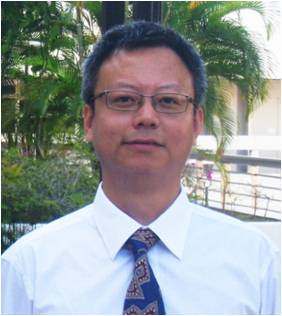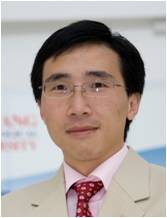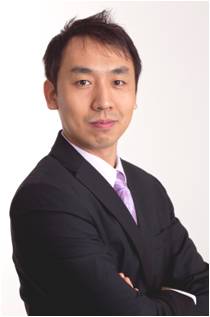【报告时间】2014年10月16日下午14:00—16:00
【报告地点】外经贸楼614
【报告人与报告题目】
1. 张华博士,Synthesis and Applications of Novel Two-Dimensional Nanomaterials
2. 范红金博士,Surface Engineering of Metal Oxide Nanostructured Electrodes: Push High-rate Performance and ultrastability
3. 于霆博士,Graphene from fundamental optics and energy storage
【报告摘要】
1.In this talk, I will summarize the recent research on synthesis, characterization and applications of two-dimensional nanomaterials in my group [1]. I will introduce the synthesis and characterization of novel low-dimensional nanomaterials, such as graphene-based composites [2] including the first-time synthesized hexagonal-close packed (hcp) Au nanostructures on graphene oxide [3], and the epitaxial growth of Pd, Pt and Ag nanostructures on solution-processable MoS2 nanoshees at ambient conditions [4], single- or few-layer metal dichalcogenide and hybrid nanosheets [5], and large-amount, uniform, ultrathin metal sulfide and selenide nanocrystals [6]. Then I will demonstrate the applications of these novel nanomaterials in chemical and bio-sensors [7], solar cells [8], water splitting [9], hydrogen evolution reaction [4, 10], electric devices [11], memory devices [12], conductive electrodes [7b, 8, 11a, 12a,b, 13], other clean energy [14], etc.
Keywords: Low-dimensional nanomaterials; Graphene; Metal dichalcogenides; Nanodevices; Field-effect transistors; Sensors; Clean energy
Reference:
[1] (a) X. Huang, et al., Chem. Soc. Rev., 2012, 41, 666. (b) X. Huang, et al., Chem. Soc. Rev., 2013, 42, 1934. (c) X. Huang, et al., Adv. Mater., 2014, 26, 2185. (d) H. Li, et al., Acc. Chem. Res., 2014, 47, 1067. (e) X. H. Cao, et al., Energ. Environ. Sci., 2014, 7, 1850. (f) H. Li, et al. ACS Nano, 2014, 8, 6563. (g) C. L. Tan, et al. Chem. Soc. Rev., DOI: 10.1039/c4cs00182f.
[2] (a) X. Y. Qi, et al., Angew. Chem. Int. Ed., 2010, 49, 9426. (b) X. Y. Qi, et al., Adv. Mater. 2012, 24, 4191. (c) X. H. Cao, et al. Angew. Chem. Int. Ed., 2014, 53, 1404.
[3] (a) X. Huang, et al., Nat. Commun. 2011, 2, 292. (b) X. Huang, et al., Angew. Chem. Int. Ed. 2011, 50, 12245. (c) X. Huang, et al., Adv. Mater. 2012, 24, 979.
[4] X. Huang, et al. Nat. Commun. 2013, 4, 1444.
[5] (a) Z. Y. Zeng, et al. Angew. Chem. Int. Ed. 2011, 50, 11093. (b) Z. Y. Zeng, et al. Angew. Chem. Int. Ed. 2012, 51, 9052. (c) Z. Y. Yin, et al. ACS Nano 2012, 6, 74. (d) H. Li, et al. ACS Nano 2013, 7, 2842. (e) Y. Y. Zhao, et al. Nano Lett. 2013, 13, 1007. (f) H. Li, et al. ACS Nano, 2013, 7, 10344. (g) Z. Y. Yin, et al., Angew. Chem. Int. Ed., 2014, DOI: 10.1002/anie.201402935. (h) X. Hong, et al. Adv. Mater., 2014, 26, 6250. (i) X. Huang, et al., ACS Nano, 2014, 8, DOI: 10.1021/nn503834u.
[6] (a) Y. P. Du, et al. Nat. Commun. 2012, 3, 1177. (b) X. J. Wu, et al. Angew. Chem. Int. Ed. 2014, 53, 5083. (c) X. J. Wu, et al. Angew. Chem. Int. Ed. 2014, 53, 8929.
[7] (a) Q. Y. He, et al., ACS Nano, 2010, 4, 3201. (b) Q. Y. He, et al., ACS Nano, 2011, 5, 5038. (c) H. G. Sudibya, et al., ACS Nano, 2011, 5, 1990. (d) C. F. Zhu, J. Am. Chem. Soc., 2013, 135, 5998.
[8] (a) Z. Y. Yin, et al. Adv. Energy Mater., 2014, 4, 1300574. (b) Z. Y. Yin, et al., ACS Nano, 2010, 4, 5263.
[9] Z. Y. Yin, et al., Adv. Mater. 2012, 24, 5374.
[10] Z. Y. Zeng, et al., Energ. Environ. Sci., 2014, 7, 797.
[11] (a) B. Li, et al., Adv. Mater., 2010, 22, 3058. (b) Z. Y. Zeng, et al., Adv. Mater., 2012, 24, 4138.
[12] (a) J. Q. Liu, et al., ACS Nano, 2010, 4, 3987. (b) J. Q. Liu, et al. Adv. Mater. 2013, 25, 233. (c) F. Zhao, et al., ACS Nano, 2012, 6, 3027. (d) G. Z. Sun, et al. Angew. Chem. Int. Ed., 2013, 52, 13351.
[13] X. Huang, et al., Adv. Mater., 2012, 24, 5979.
[14] (a) G. Z. Sun, et al., Angew. Chem. Int. Ed., 2014, DOI: 10.1002/anie.201405325. (b) D. Yang, et al., Angew. Chem. Int. Ed., 2014, 53, 9352.
2. The performance of electrochemical energy storage devices relies largely on a scrupulous design of nanoarchitectures and smart hybridization of active materials. Metal oxides are widely applied as electrode materials for both batteries and psuedocapacitors because of their high capacity. However due to their poor conductivity and stability, which lower their rate performance and capacity stability over long cycles. To overcome this, conventionally, additional additives are needed. More recently, hybridization of inorganic nanomaterials with carbon becomes an effective approach to enhance the rate performance and cycling stability.
Our group has been actively working on core-shell integrated electrode materials directly on various conductive substrates for both supercapacitors and batteries. In this talk I will present our recent results on vanadium oxide and copper oxides nanorods that are direct grown onto 3D graphene foams. To further enhance their electrochemical performance, the nanorods are surface engineered by coating a thin layer of conductive polymers or carbon nanostructures dots. Demonstration will be made to supercapacitors, Li-ion and Na-ion battery electrodes, all exhibiting improved capacity, fast (up to a few min) charging and discharging capability, and ultrahigh cycling stability (up to 40 000 cycles).
3. Graphene, as an exceptional two dimensional material, possess extremely promising potential for fundamental studies and practical applications. In this talk, I will present our recent findings and understandings of the optical properties of graphene. Photons, electrons, phonons and the interaction among them are systematically investigated through various optical probes. Meanwhile, the great potential of graphene and its derivatives for energy storages will also be discussed.
【报告人简介】
 1. Dr. Hua Zhang obtained his B.S. and M.S. degrees at Nanjing University in China in 1992 and 1995, respectively, and completed his Ph.D. with Prof. Zhongfan Liu at Peking University in China in July 1998. He joined Prof. Frans C. De Schryver’s group at Katholieke Universiteit Leuven (KULeuven) in Belgium as a Research Associate in January 1999. Then he moved to Prof. Chad A. Mirkin’s group at Northwestern University as a Postdoctoral Fellow in July 2001. He started to work at NanoInk Inc. (USA) as a Research Scientist/Chemist in August 2003. After that, he worked as a Senior Research Scientist at Institute of Bioengineering and Nanotechnology in Singapore from November 2005 to July 2006. Then he joined the School of Materials Science and Engineering in Nanyang Technological University (NTU) as an Assistant Professor. He was promoted to a tenured Associate Professor on March 1, 2011, and Full Professor on Sept. 1, 2013.
1. Dr. Hua Zhang obtained his B.S. and M.S. degrees at Nanjing University in China in 1992 and 1995, respectively, and completed his Ph.D. with Prof. Zhongfan Liu at Peking University in China in July 1998. He joined Prof. Frans C. De Schryver’s group at Katholieke Universiteit Leuven (KULeuven) in Belgium as a Research Associate in January 1999. Then he moved to Prof. Chad A. Mirkin’s group at Northwestern University as a Postdoctoral Fellow in July 2001. He started to work at NanoInk Inc. (USA) as a Research Scientist/Chemist in August 2003. After that, he worked as a Senior Research Scientist at Institute of Bioengineering and Nanotechnology in Singapore from November 2005 to July 2006. Then he joined the School of Materials Science and Engineering in Nanyang Technological University (NTU) as an Assistant Professor. He was promoted to a tenured Associate Professor on March 1, 2011, and Full Professor on Sept. 1, 2013.
He has published 5 invited book chapters, 53 patent applications (including 8 granted US patents), and over 290 papers, among which 267 papers were published in the journals with IF>3 (including 97 papers published in IF>10 journals and 525 papers published in 7<IF<10 journals). Some of his papers have been published in Science, Nat. Chem., Nat. Commun., Chem. Soc. Rev., Acc. Chem. Res., Angew. Chem. Int. Ed., Adv. Mater., J. Am. Chem. Soc., Nano Lett., ACS Nano, Adv. Energy Mater., Energy Environ. Sci., Adv. Funct. Mater., Chem. Sci., Chem. Mater., Small, etc. Based on Web of Science on Oct. 2, 2014, the total citation of his papers is over 13,000 with H-index of 57. He has been invited to give more than 180 Plenary, Keynote or Invited Talks in many international conferences, universities and institutes, and serve as Session Chair. He has organized several international conferences and served as Symposium Chair or Conference Co-Chair. He is an Associate Editor of International Journal of Nanoscience (2007-), sits on the Advisory Board of Chem. Soc. Rev. (2012-) and Nanoscale (2012-), the Editorial Advisory Board of ACS Nano (2014-), Chem. Mater. (2014-), ACS Appl. Mater. Interfaces (2014-), Small (2012-) and Nanofabrication (2012-), the Editorial Board of Carbon (2013-) and NANO (2007-), and the International Advisory Board of Materials Research Express (2014-) and ChemPlusChem (2012-). He is also one of the members of the Advisory Committee of IOP Asia-Pacific (2010-). He was selected to the 2014 The World's Most Influential Scientific Minds and the Highly Cited Researchers 2014 (Thomson Reuters, 2014) and listed one of 17 “Hottest Researchers of Today” in the world, and got the World Cultural Council (WCC) Special Recognition Award (2013), the ONASSIA Foundation Lectureship (Greece, 2013), Asian Rising Stars (15th Asian Chemical Congress, 2013), SMALL Young Innovator Award (Wiley-VCH, 2012) and Nanyang Award for Research Excellence (2011).
Dr. Zhang’s research is highly interdisciplinary. His current research interests focus on synthesis of two-dimensional nanomaterials (graphene and transition metal dichalcogenides), carbon materials (graphene and CNTs) and their hybrid composites for various applications in nano- and biosensors, clean energy, water remediation, etc.; controlled synthesis, characterization and application of novel metallic and semiconducting nanomaterials; scanning probe microscopy; lithography-based fabrication of surface structures from micro- to nanometer scale; self-assembly and self-organization of nano- and biomaterials; self-assembled monolayers; etc.
 2. 范红金,博士,目前为新加坡南洋理工大学物理系副教授。1999年获吉林大学学士学位,2003年获新加坡国立大学博士学位,其后分别在德国马普研究所和英国剑桥大学
2. 范红金,博士,目前为新加坡南洋理工大学物理系副教授。1999年获吉林大学学士学位,2003年获新加坡国立大学博士学位,其后分别在德国马普研究所和英国剑桥大学
 3. 于霆,博士,南洋副教授,博士生导师。1999年毕业于吉林大学,2000年至2003年于新加坡国立大学学习并获博士学位,2003年获新加坡千禧年博士后奖资助工作于新加坡国立大学至2005年。2005年9月加入新加坡南洋理工大学任讲师,博士生导师, 2008年7月提升为助理教授, 2010年1月聘为南洋助理教授。2014年一月获终生职位并提升为南洋副教授。现任美国材料学会,美国化学学会, 美国物理学会,新加坡物理学会,材料学会会员。主持多个国际,新加坡国家重大项目研究课题工作。从事纳米碳材料,纳米金属氧化物,二维材料的生长, 表征, 器件, 以及新能源等方面的工作。最近几年, 于博士小组对石墨烯和其他二维材料的工作得到了该领域的普遍关注。于博士先后在国际一流杂志发表科学论文190余篇,被他引6700多次, H因子46, 持有4项发明专利, 并共同编著了<<近场光学影像>>,<<纳米金属氧化物>>,《二维碳材料的基本特性,制备,表征和应用》等书目。于博士获得过的奖励包括:新加坡千禧年博士后奖(2003),南洋科研创新奖(2008),新加坡杰出青年科学家奖(2009),新加坡国家科研基金研究员奖(2010),世界达沃斯经济论坛杰出青年科学家奖(2010), 新加坡物理学会纳米科技奖(2011) 等等。
3. 于霆,博士,南洋副教授,博士生导师。1999年毕业于吉林大学,2000年至2003年于新加坡国立大学学习并获博士学位,2003年获新加坡千禧年博士后奖资助工作于新加坡国立大学至2005年。2005年9月加入新加坡南洋理工大学任讲师,博士生导师, 2008年7月提升为助理教授, 2010年1月聘为南洋助理教授。2014年一月获终生职位并提升为南洋副教授。现任美国材料学会,美国化学学会, 美国物理学会,新加坡物理学会,材料学会会员。主持多个国际,新加坡国家重大项目研究课题工作。从事纳米碳材料,纳米金属氧化物,二维材料的生长, 表征, 器件, 以及新能源等方面的工作。最近几年, 于博士小组对石墨烯和其他二维材料的工作得到了该领域的普遍关注。于博士先后在国际一流杂志发表科学论文190余篇,被他引6700多次, H因子46, 持有4项发明专利, 并共同编著了<<近场光学影像>>,<<纳米金属氧化物>>,《二维碳材料的基本特性,制备,表征和应用》等书目。于博士获得过的奖励包括:新加坡千禧年博士后奖(2003),南洋科研创新奖(2008),新加坡杰出青年科学家奖(2009),新加坡国家科研基金研究员奖(2010),世界达沃斯经济论坛杰出青年科学家奖(2010), 新加坡物理学会纳米科技奖(2011) 等等。

